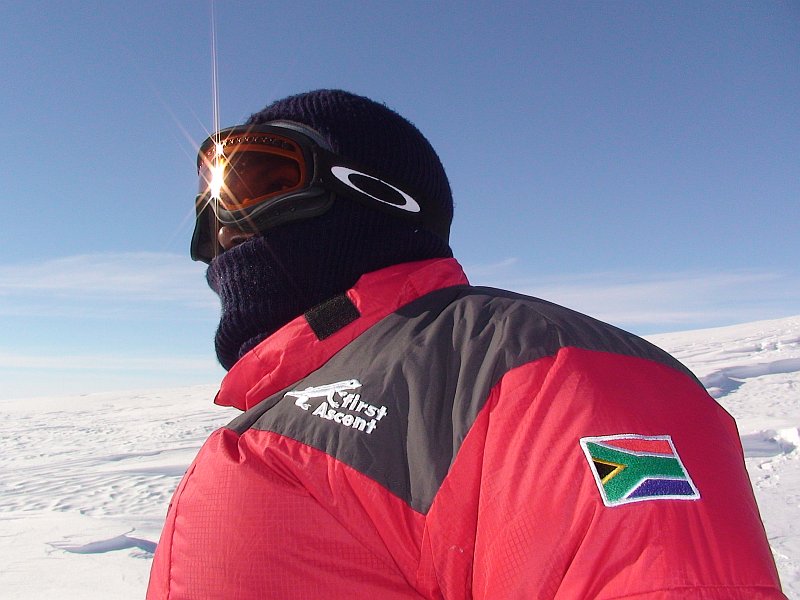Thick and fast
March 17th, 2008Perhaps it is only subjective, but I get the impression that summer has faded and the weather conditions are deteriorating. The ‘balmy’ blue-sky days with temperatures only a few degrees below zero are a thing of the past. If we have blue sky now, it is usually accompanied by a 20 knot wind and ambient temperature between -10 and -20°C. More common, however, are the overcast ‘white-out’ days, when the uniform cloud and snowfields assume the same featureless shade of white. Any snowy or icy surface loses definition; there is no shadow, no texture; only the rocks and man-made objects stand out black upon the endless white, like words of an ee cummings poem scattered across an almost blank page.
Also more common are the days of heavy weather. The paraglider pilot locked inside me cannot help watching the wind, and we’ve gradually become more astute at judging it’s strength by the changes visible through the bases triple-glazed windows. At around 20 knots, the finest snow flows across the surface, snaking in streams between the rocks and gliding over blue ice. At 30 knots, the ground disappears underneath an ocean of drifting snow, writhing, twisting, flowing like the froth of a raging river under the base and over the cliff beyond. Above 40 knots, the world disappears as the base is swallowed by the maelstrom. At 50, the crockery on it’s rack in the dining hall starts to rattle, the base hums to the tune of the wind, and every object becomes charged with static electricity. The power is unmistakeable; we place our trust in the sturdiness of the base and imagine being the warm heart of the storm.
This past weekend, despite hopes of pleasant weather to allow us to get outdoors for some R&R, brought the strongest wind we’ve yet experienced. On Sunday morning I was enjoying a dream of being back aboard the Agulhas, feeling the occasional jolt as she pushed aside a particularly recalcitrant piece of ice, when I realised the shudders were not limited to the world of my dream. Awakening, it became apparent that the entire base was shaking in gusts of wind. As I looked out through the window, I could see polarised stress lines forming in the perspex as the outer layer deformed. Snow striking the window made a pattering not unlike rain – a sound I have come to miss. A quick trip to the meteorological office confirmed my suspicions – this was the strongest wind yet. Peaking at over 70 knots (130km/h) and driving every iota of loose snow before it, the wind soon found our weakness. A meter-square, thick insulated hatch in the physics lab roof was blown off the building, to disappear into the storm. We plugged the hole temporarily, but there were some nervous remarks around the dining room table as we drank coffee thereafter. However, it was only later that the bombshell dropped.
Right after dinner, our mechanical engineer Anton came back from doing base checks to report that the snow smelter was not drawing any current. Furthermore, our water supplies had taken a knock during the day, convincing us that no new water had pumped up from the smelter. To add final insult, the pumps on the fuel line at the diesel bunkers – used to fill the day tank supplying our generators – had stopped responding. One cause for the problems presented itself: the static buildup had tripped the ‘smelly’ and fuel pumps. The fuel situation was not critical – we could run for another 24 hours with the supplies available – but if the smelter is allowed to freeze it becomes impossible to make water, and very tricky to start it again. Expanding ice as the water froze could also damage the system, so it was critical to get down to the smelter, dig out the hatch, and access the control room under the ice to assess the problem. I bade the team dress and prepare, and then we met to brief for the ‘mission’.
Eight were to go out, in buddy teams, following the pipeline down to the smelter. I had fortunately fixed a rope for the last section (where the pipe disappears into the snow) during the last storm, so we could reach the smelter with a hand-hold all the way. Once there, we would have to dig down through the compacted snow to reach the hatch, open it, and climb down the ladder into the control room. Some would have to stay above, keeping the hatch open and clear of snow, whilst the technical team checked the electronic controllers and power supply. Strict safety precautions and buddy checks were agreed upon, and we ventured out.
Underneath the base the wind was accelerated to an incredible degree. Touching any object resulted in immediate and repetitive shocks, as the static electricity built and discharged. One buddy team opted to turn back immediately; it was a struggle just to walk into the fury of the wind. The remaining six slogged over to the pipeline and then fought for every step down to the smelter. The true battle began only then; with goggles icing rapidly, we had to dig almost by feel, trying to clear the heavy hatch of snow while the wind snatched at the shovels. After a few minutes we managed to open the hatch. Saziso and I slipped down the ladder and and were greeted by the happy sight of the machinery lit and working. More detailed inspection revealed that the water was at 30°C in the tank – a thick ice bridge had formed, preventing new snow falling in, and the elements had shut down to prevent the water overheating. This explained the lack of current being drawn from the generators. We were safe from freezing. The smelter, protected by thick ice, had not tripped.
To make certain that the pipeline had not become blocked by ice, we pumped hot water up to the base for around 30 minutes. By now, the rest of the team had become very cold, where they waited above, keeping the hatch clear of snow. While Saz tended to the machines, I replaced them, sitting in the hatch but holding it closed across my legs to prevent too much snow falling in, and sent the remaining four back to the base. Sitting like this, body exposed to the gale, I was grateful for the top-spec First Ascent mountaineering jacket I was wearing, and the thick fleece underneath. Completely ensconced, I watched through my frozen goggles as the snow billowed around me. Moisture on my gloves from inside the control room froze into solid ice and my breath caused a mask of ice to form across the soft-shell balaclava I wore, which I had to break free every few minutes as breathing became difficult. With even very conservative wind-chill factored in, the relative temperature was -40°C. Bare flesh would become frostbitten in minutes, but inside my shell of protective gear I cooled slowly. Almost like a form of meditation, the buffeting of the gale and roar of blown snow striking my hood became peaceful; my mind drained of thought, breathing slowed, and I found myself as a calm oasis in the cold chaos. Perhaps this is why I have always loved foul weather; it shrinks your world down to personal endeavour; it leaves you alone against the elements, but the loneliness, the isolation allows your introspective thoughts to become clear without the sensory overload of normal life. For me, sitting in a storm which demonstrates my fragile insignificance defines my very presence.



